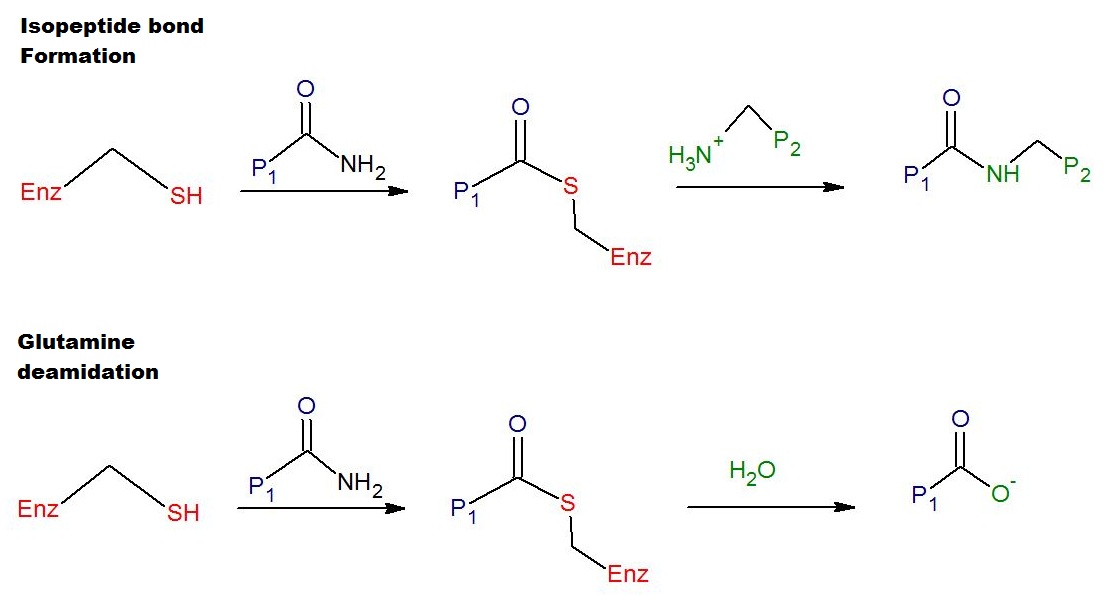|
Streptomyces Mobaraensis
''Streptomyces mobaraensis'' is a spore forming bacterium species from the genus of ''Streptomyces''. ''Streptomyces mobaraensis'' produces bleomycin, detoxin, piericidin A, piericidin B, reticulol and transglutaminase. ''Streptomyces mobaraensis'' is used in the food industry to produce transglutaminase to texture meat and fish products. Further reading * * * * * * * * * * * * See also * List of Streptomyces species A ''list'' is any set of items in a row. List or lists may also refer to: People * List (surname) Organizations * List College, an undergraduate division of the Jewish Theological Seminary of America * SC Germania List, German rugby union ... References External linksType strain of ''Streptomyces mobaraensis'' at Bac''Dive'' - the Bacterial Diversity Metadatabase mobaraensis Bacteria described in 1991 ... [...More Info...] [...Related Items...] OR: [Wikipedia] [Google] [Baidu] |
Deutsche Sammlung Von Mikroorganismen Und Zellkulturen
The Leibniz Institute DSMZ - German Collection of Microorganisms and Cell Cultures GmbH (German: ''Leibniz-Institut DSMZ-Deutsche Sammlung von Mikroorganismen und Zellkulturen GmbH''), located in Braunschweig, is a research infrastructure in the Leibniz Association. Also the DSMZ is the world's most diverse collection of bioresources (status 2021: 75,000 bioresources). These include microorganisms (including more than 32,000 bacterial strains, 690 archaeal strains, 7,000 strains of yeasts and fungi) as well as more than 840 human and animal cell cultures, over 1. 500 plant viruses, over 940 bacteriophages, and 250 plasmids (status 2021). Since 2010, the scientific director of the Leibniz Institute DSMZ has been Jörg Overmann, a microbiologist with a PhD. He holds a professorship in microbiology at the Technical University of Braunschweig. Since August 2018, he has led the institute in a dual leadership with Bettina Fischer as administrative director. History Structure ... [...More Info...] [...Related Items...] OR: [Wikipedia] [Google] [Baidu] |
Streptomyces
''Streptomyces'' is the largest genus of Actinomycetota and the type genus of the family Streptomycetaceae. Over 500 species of ''Streptomyces'' bacteria have been described. As with the other Actinomycetota, streptomycetes are gram-positive, and have genomes with high GC content. Found predominantly in soil and decaying vegetation, most streptomycetes produce spores, and are noted for their distinct "earthy" odor that results from production of a volatile metabolite, geosmin. Streptomycetes are characterised by a complex secondary metabolism. They produce over two-thirds of the clinically useful antibiotics of natural origin (e.g., neomycin, streptomycin, cypemycin, grisemycin, bottromycins and chloramphenicol). The antibiotic streptomycin takes its name directly from ''Streptomyces''. Streptomycetes are infrequent pathogens, though infections in humans, such as mycetoma, can be caused by '' S. somaliensis'' and '' S. sudanensis'', and in plants can be caused by '' S. cavi ... [...More Info...] [...Related Items...] OR: [Wikipedia] [Google] [Baidu] |
Bleomycin
-13- (1''H''-imidazol-5-yl)methyl9-hydroxy-5- 1''R'')-1-hydroxyethyl8,10-dimethyl-4,7,12,15-tetraoxo-3,6,11,14-tetraazapentadec-1-yl}-2,4'-bi-1,3-thiazol-4-yl)carbonyl]amino}propyl)(dimethyl)sulfonium , chemical_formula = , C=55 , H=84 , N=17 , O=21 , S=3 , molecular_weight = 1415.551 , SMILES = CC1=C(N=C(N=C1N) @HCC(=O)N)NC @@HC(=O)N)N)C(=O)N @@HC(C2=CN=CN2)O @H @H @H @@H @@HO3)CO)O)O)O @@H @H @H @@H @HO4)CO)O)OC(=O)N)O)C(=O)N @HC) @H @HC)C(=O)N @@H @@HC)O)C(=O)NCCC5=NC(=CS5)C6=NC(=CS6)C(=O)NCCC +C)C)O , Jmol = , StdInChI_Ref = , StdInChI = 1S/C55H83N17O21S3/c1-20-33(69-46(72-44(20)58)25(12-31(57)76)64-13-24(56)45(59)82)50(86)71-35(41(26-14-61-19-65-26)91-54-43(39(80)37(78)29(15-73)90-54)92-53-40(81)42(93-55(60)88)38(79)30(16-74)89-53)51(87)66-22(3)36(77)21(2)47(83)70-34(23(4)75)49(85)63-10-8-32-67-28(18-94-32)52-68-27(17-95-52)48(84)62-9-7-11-96(5)6/h14,17-19,21-25,29-30,34-43,53-54,64,73-75,77-81H,7-13,15-16,56H2,1-6H3,(H13-,57,58, ... [...More Info...] [...Related Items...] OR: [Wikipedia] [Google] [Baidu] |
Piericidin A
Piericidin A is an antibiotic agent. It was discovered from '' Streptomyces mobaraensis''. Being an inhibitor of NADH dehydrogenase, it inhibits electron transfer; its structure resembles that of the ubiquinone, therefore it competes with QB for binding sites in NADH dehydrogenase as well as Photosystem II Photosystem II (or water-plastoquinone oxidoreductase) is the first protein complex in the light-dependent reactions of oxygenic photosynthesis. It is located in the thylakoid membrane of plants, algae, and cyanobacteria. Within the photosystem .... References 4-Pyridones NADH dehydrogenase inhibitors Alcohols {{alcohol-stub ... [...More Info...] [...Related Items...] OR: [Wikipedia] [Google] [Baidu] |
Transglutaminase
Transglutaminases are enzymes that in nature primarily catalyze the formation of an isopeptide bond between γ-carboxamide groups ( -(C=O)NH2 ) of glutamine residue side chains and the ε-amino groups ( -NH2 ) of lysine residue side chains with subsequent release of ammonia ( NH3 ). Lysine and glutamine residues must be bound to a peptide or a protein so that this cross-linking (between separate molecules) or intramolecular (within the same molecule) reaction can happen. Bonds formed by transglutaminase exhibit high resistance to proteolytic degradation (proteolysis). The reaction is :Glutamine, Gln-(C=O)NH2 + Lysine, NH2-Lys → Gln-(C=O)NH-Lys + NH3 Transglutaminases can also join a primary amine ( RNH2 ) to the side chain carboxyamide group of a protein/peptide bound glutamine residue thus forming an isopeptide bond :Gln-(C=O)NH2 + RNH2 → Gln-(C=O)NHR + NH3 These enzymes can also Deamidation, deamidate glutamine residues to glutamic acid residues ... [...More Info...] [...Related Items...] OR: [Wikipedia] [Google] [Baidu] |
List Of Streptomyces Species
A ''list'' is any set of items in a row. List or lists may also refer to: People * List (surname) Organizations * List College, an undergraduate division of the Jewish Theological Seminary of America * SC Germania List, German rugby union club Other uses * Angle of list, the leaning to either port or starboard of a ship * List (information), an ordered collection of pieces of information ** List (abstract data type), a method to organize data in computer science * List on Sylt, previously called List, the northernmost village in Germany, on the island of Sylt * ''List'', an alternative term for ''roll'' in flight dynamics * To ''list'' a building, etc., in the UK it means to designate it a listed building that may not be altered without permission * Lists (jousting), the barriers used to designate the tournament area where medieval knights jousted * ''The Book of Lists'', an American series of books with unusual lists See also * The List (other) * Listing (d ... [...More Info...] [...Related Items...] OR: [Wikipedia] [Google] [Baidu] |

